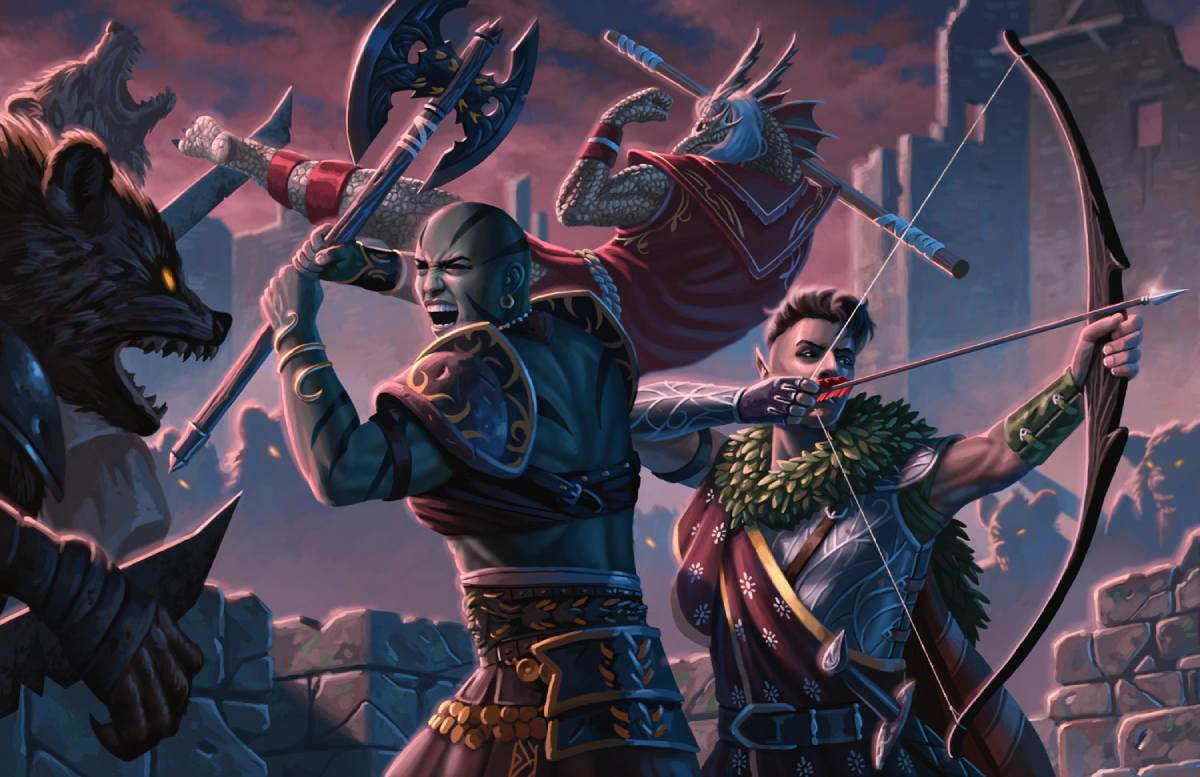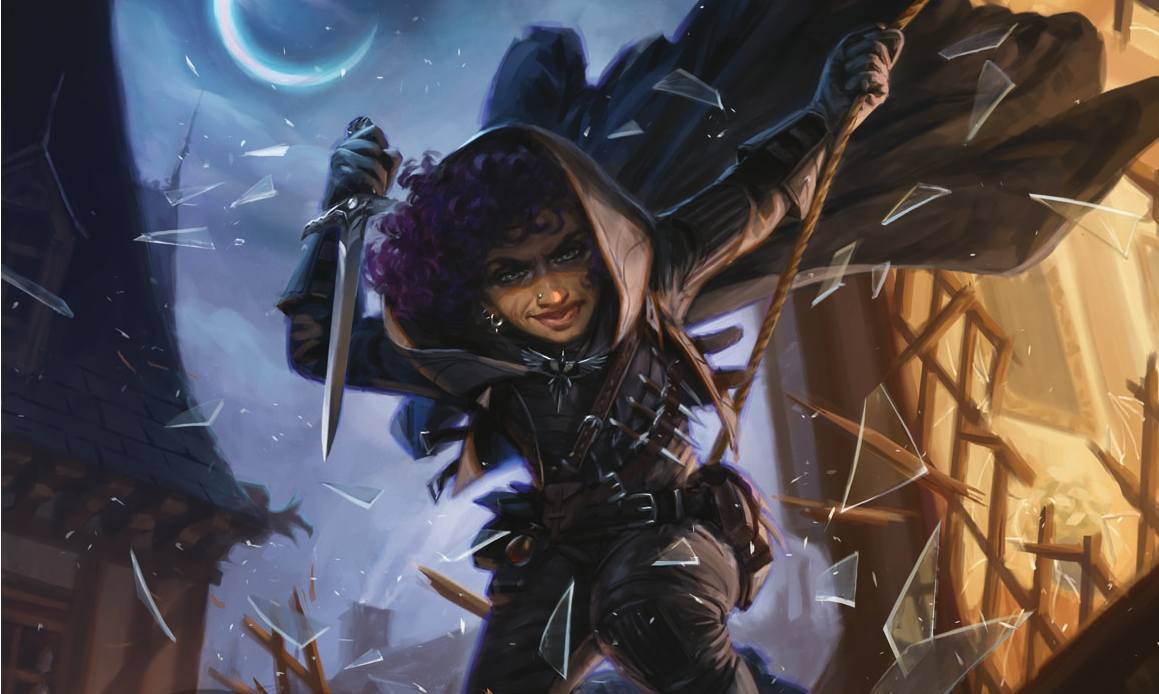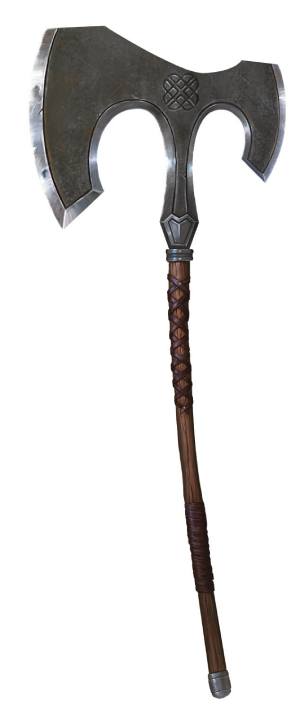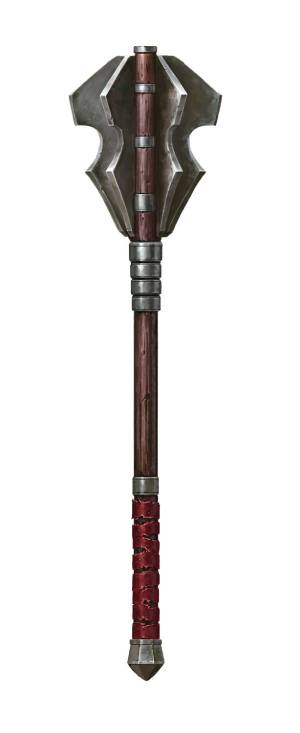The Fighter uses their Maul to knock down their opponent, the Rogue dances around with their Rapier to find their foe’s weak point, and the Barbarian swings a Greataxe through two enemies with a single blow. Every character in D&D has a unique flare they bring to combat, and that’s reflected in the new Weapon Mastery feature in the Player’s Handbook!
Let’s explore these fresh ways to utilize your weapons in the upcoming core rulebook revamp!
Build Your Warrior Today
Start building your weapon-wielding warrior today in D&D Beyond's Character Builder. You can access Weapon Mastery for free using the D&D Beyond Basic Rules, so you can test out this new brand-new system and start cutting a heroic path through your foes!
What is Weapon Mastery?

Weapon Mastery is a class feature shared between some martial classes that reflects their specialization with certain types of weapons.
Each weapon in the Equipment section of the 2024 Player’s Handbook lists a mastery property in addition to the weapon’s regular properties. If the weapon meets the requirements in your class's Weapon Mastery feature, you can learn its mastery property and use it in combat.
But learning a mastery property isn't permanent. If you stumble across a shiny new +1 Longsword and want to learn its mastery properties instead, don’t worry! During a Long Rest, you can practice weapon drills and swap out one of your weapon choices at the end of the rest.
The number of mastery properties you can learn is specified in your class's version of the Weapon Mastery feature. Rogues, rangers, and paladins can only access two mastery properties at a time, whereas barbarians and fighters start with two and three, respectively, and eventually gain access to more mastery properties, as detailed in their Features table.
At level 1, Barbarians, Fighters, Paladins, Rangers, and Rogues get access to the mastery properties for certain types of weapons, as listed below:
- Barbarian: Simple and Martial Melee weapons
- Fighter: Simple and Martial weapons
- Paladin: Based on weapon proficiencies (Simple and Martial weapons)
- Ranger: Based on weapon proficiencies (Simple and Martial weapons)
- Rogue: Based on weapon proficiencies (Simple weapons and Martial weapons with the Finesse or Light property)
Mastering Weapon Mastery
Some subclasses allow you to access more mastery properties. For example, the Soulknife Rogue can use the Vex mastery property with their Psychic Blades and it doesn’t count toward their learned Weapon Mastery limit.
How to Use Weapon Mastery Properties
If you’re wielding a weapon and have learned its mastery property, you’ll be able to use that mastery property every turn when you make an attack with the weapon.
Different mastery properties have different triggers. For example, Cleave requires you to hit a creature with a melee attack roll while Graze triggers when you miss a creature with an attack roll.
Unlike some abilities, there’s no limit to how many times mastery properties can be used per Short or Long Rest, so go nuts!
Mastery Properties Overview

Below, we’ll cover each of the eight mastery properties included in the 2024 Player’s Handbook. We’ll even throw in some tips to help you brainstorm ideas for your new characters!
Cleave

Example Weapon: Greataxe
If you’ll be wading into the thick of battle, you’ll want to consider grabbing a weapon with the Cleave property.
These heavy weapons can slash through opponents. If you hit a creature with a melee weapon attack, you can make a second attack against a creature within 5 feet that is also within your reach. When you hit with the second attack, you can roll your weapon’s damage, but you don’t add your ability modifier unless it’s negative.
This is excellent in combination with the Halberd, which has Reach and Cleave, allowing you to Cleave into enemies in an extended range.
Graze
Example Weapon: Greatsword
Graze is an excellent way to increase the consistency of your weapon damage.
If you miss a creature with your weapon, you deal damage equal to the ability modifier you used to make the roll. This pairs well with abilities that allow you to make a lot of attacks, like the Fighter’s Extra Attacks features or the Polearm Master or Sentinel feats.
It just goes to show that when a weapon is big enough, you don't really need to aim where you're swinging.
Nick
Example Weapon: Dagger
To explain the Nick property, we should briefly cover that being able to attack twice while dual-wielding Light weapons has subtly changed in the 2024 Player’s Handbook. Instead of being covered under Melee Attacks, the rules for dual-wielding Light weapons are covered under the Light weapon property.
It still functions the same way: When you make an attack with a weapon that has the Light property, you can use a Bonus Action to make one attack with a different Light weapon you’re wielding.
The Nick mastery property allows you to make the additional attack you receive from wielding two Light weapons as part of the initial attack action.
Keep in mind that this doesn’t mean you can make a third attack as a Bonus Action, as the Light property specifies you only get one extra attack. But, while it may not pump your damage, this frees up your Bonus Action to use class/species abilities, such as the Rogue’s Cunning Action, while still getting an additional attack in.
Push
Example Weapon: Greatclub
Sometimes giving an enemy a simple shove off a cliff or into a pit of lava is all you need to win an otherwise tough encounter! The Push mastery property allows you to launch a creature you hit 10 feet straight away from you without a save.
Not only is this great when combined with environmental hazards, it's also great for escaping Opportunity Attacks. If you or a less tanky party member are being harassed by an enemy, you can push the enemy 10 feet away, which can allow you to create the space needed to escape unscathed.
Keep in mind that you can only push enemies Large or smaller, so don’t go getting stuck next to an Adult Black Dragon.
Sap

Example Weapon: Mace
If your job is to distract the enemies for long enough to let your blaster caster friends deal with them, Sap is a solid choice.
When you hit an enemy with an attack, this mastery property inflicts Disadvantage on your target’s next attack roll before the start of your next turn.
So, for heavily armored, tanky builds, your enemies will be so focused on trying to take you out that they won’t even see the Fireball coming.
Slow
Example Weapon: Light Crossbow
This mastery property is excellent for fast builds that like to flit across the battlefield. When you hit a creature and deal damage, you can reduce its Speed by 10 feet until the start of your next turn.
This combos excellently with the Light Crossbow, allowing you to take shots, damage your opponents, and then move to just out of range of their reduced Speed. Rinse and repeat until they look like a pin cushion.
It’s important to note that a creature hit more than once by weapons with this property doesn't have its Speed reduced any more than 10 feet. So don’t expect to stand still, hit your enemy three times, and not get caught.
Topple
Example Weapon: Maul
This mastery property is for all those builds that love to wail on their enemies with multiple melee attacks.
When you hit a creature, you can force it to make a Constitution saving throw or fall Prone. The DC for this save is 8 plus the ability modifier used to make the attack plus your Proficiency Bonus.
So, a level 5 Fighter with a Maul could knock their opponent Prone with their first attack, then use their second attack and Action Surge to make multiple attacks with Advantage.
Just remember attacking Prone enemies outside of 5 feet actually gives the attacker Disadvantage on their attack roll. So only use this ability if you or another melee-minded party member can take advantage of it.
Vex
Example Weapon: Shortsword
Having a weapon with Vex feels like a superior swordsman dancing around their opponent, striking at openings until the battle is won.
When you hit a creature and deal damage, this mastery property gives you Advantage on your next attack roll before the end of your next turn. This is an excellent way for Rogues to all but guarantee a Sneak Attack hit on their next turn.
The Student Becomes the Master
The 2024 Player’s Handbook is now available on the D&D Beyond marketplace, which means it's time to set out on new adventures with fresh or familiar characters!
Weapon Mastery is a fun way to give martial characters more choice in combat. It also revamps the way weapons feel in D&D. The new options and revisions presented in this book are a result of a decade of lessons learned and adventures had. With updated rules and streamlined gameplay, it's never been easier to bring your stories to life.
We’re delighted to share with you the changes to fifth edition D&D that appear in the 2024 Player’s Handbook. Make sure to keep an eye out on D&D Beyond for more useful guides on using the wealth of new options, rules, and mechanics found in the 2024 Player's Handbook!

Mike Bernier (@arcane_eye) is the founder of Arcane Eye, a site focused on providing useful tips and tricks to all those involved in the world of D&D. Outside of writing for Arcane Eye, Mike spends most of his time playing games, hiking with his partner, and tending the veritable jungle of houseplants that have invaded his house.
This article was updated on August 12, 2024, to issue corrections or expand coverage for the following features:
- What is Weapon Mastery?: Made clear that the Rogue is proficient with all Simple weapons.
- Slow: Clarified that the Slow property doesn't stack with itself.








-
View User Profile
-
Send Message
Posted Aug 1, 2024All martial classes should get Weapon Mastery on default.
-
View User Profile
-
Send Message
Posted Aug 3, 2024The 2014 dual-wielding rule specifically refers to melee weapons. The 2024 Light property doesn't seem to be limited to melee weapons. I like this change because it allows for dual-wielding with a hand crossbow without requiring Crossbow Expert (which is still a useful feat as updated in UA).
-
View User Profile
-
Send Message
Posted Aug 5, 2024The monk got more dmg tho and better grappling OH and subclasses that can literally make you deal elemental dmg with increased range
-
View User Profile
-
Send Message
Posted Aug 6, 2024can't wait to play as a hexblade, pact of the blade warlock with the weapon mastery feat. gonna have lots of fun switching my loadout every day lol
-
View User Profile
-
Send Message
Posted Aug 7, 2024I'm wondering this as well, neither the wording in the Nick mastery nor the Light property makes it clear which weapon should have Nick, the one making the initial attack or the one making the extra attack.
-
View User Profile
-
Send Message
Posted Aug 8, 2024Agree
-
View User Profile
-
Send Message
Posted Aug 8, 2024War Gamer article just blew my mind. You can pull off a nick attack and a dual wield bonus attack you just need to equip two weapons. They claim you can even still use a shield to get 2 extra attacks. so at level 5 you are attacking 4 times. At level 20 you are attacking 6 times!
https://www.wargamer.com/dnd/overpowered-weapon-mastery-nick
-
View User Profile
-
Send Message
Posted Aug 10, 2024My opinion is that the off-hand weapon is the one that needs the Nick property because that is the one that gets the attack as part of the main attack instead of a bonus action. The main-hand weapon can (and should!) have another weapon property so that it can also be used. Having Nick on both your off-hand and your main-hand weapons provides no real benefit, RAW.
-
View User Profile
-
Send Message
Posted Aug 10, 2024Something I have yet to see if Weapon Mastery for unarmed, esp with unarmed fighting style being a thing...
-
View User Profile
-
Send Message
Posted Aug 11, 2024Imagine being an Echo Knight with this :3.
-
View User Profile
-
Send Message
Posted Aug 13, 2024I'm not sure how Sap accomplishes their example. Would be more fitting if it gave them disadvantage on their next d20 Test. That said, I love these!
-
View User Profile
-
Send Message
Posted Aug 14, 2024Hope this is an acceptable place to ask this - does anyone have any insight into how the 'Nick' weapon property would interact with the Duel Wielder feat?
The Nick mastery property allows you to make the additional attack you receive from wielding two Light weapons as part of the initial attack action. Duel wielder would let you make an off hand attack with a non-two handed weapon, for example a longsword. But using a longsword in your offhand would appear to negate the Nick weapon mastery property (assuming you only have two hands - looking at you thri kreen). Is this how others see it or due you anticipate stowing/drawing shenanigans?
-
View User Profile
-
Send Message
Posted Aug 14, 2024Based on the way that the Dual Wielder feat was worded in UA, if you have that feat, using a longsword in your off hand doesn't negate the Nick property of a Light weapon in your main hand. This is because the feat says that if you're holding a Light weapon in one hand, you can treat a non-Light weapon in your other hand as if it were Light, meaning it would satisfy the requirements for using the extra attack granted by the Nick property. (This is quite different from how the 2014 version of this feat worked.)
-
View User Profile
-
Send Message
Posted Aug 14, 2024Thanks for the swift clarification, hope that makes it into the final version!
-
View User Profile
-
Send Message
Posted Aug 14, 2024Thanks for the swift clarification, hope that wording makes it into the final version!
-
View User Profile
-
Send Message
Posted Aug 16, 2024I always liked the idea of the Dagger Wielding rogue but the 1d4 damage was always suboptimal when I could just use short swords. Nick sounds like a very good reason to use daggers to free up my bonus action for hiding/disengaging :D
-
View User Profile
-
Send Message
Posted Aug 17, 2024Yeah, this is one of my favorite things that the the next edition has added so far.
-
View User Profile
-
Send Message
Posted Aug 17, 2024No kidding, I would tell players that asked what is a good weapon to choose was, "Just look at the traits and pick the highest damage die total". Weapon Mastery is something that I almost made myself but I was calling it, Weapom Skills. Similar ideas and such. I like these a lot. Can't wait!
Also...I have been wanting some feedback on a hombrew setting I am working on. A new world, new rules, in depth crafting and lore and many other things will be posted on the Forum: Welcome to Zionderia in the DM's Guild. It isn't offical and is under work right now. I have many ideas and such on my phones notes, and I am organizing and proofreading them before I post them so posting is slow. Anyway, feedback would be nice, please at least check it out.
-
View User Profile
-
Send Message
Posted Aug 18, 2024I seem to recall a 3.5 class or prestige class that specialized in daggers and one of their abilities increased the damage of any daggers they used from d4's to d6's instead. Can't remember the name of the class, but I think something like that would be cool to see brought into 5e.
-
View User Profile
-
Send Message
Posted Aug 19, 2024Yeah I agree. I never tried any of the other editions below 5th, but that sounds awesome. Looks like an unarmed Fighting buff but for Daggers! That would be great for rogues, sort of a monk buff for Daggers. Probabaly should keep it low compared to monk attacks so that Rogues don't stay OP to Monks, but if they added new stuff to monks, it could be fine.